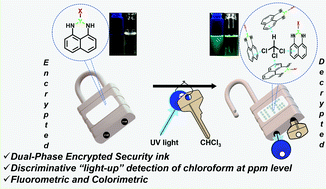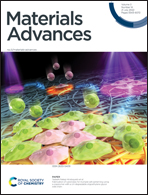Discriminative light-up detection of volatile chlorinated solvents and dual-phase encrypted security ink†
Abstract
The highly toxic nature of volatile chlorinated solvents (VCSs) demands precise detection and discrimination techniques to check the quality of air and groundwater. However, the analogous structural behaviour of these VCSs makes this highly challenging. Herein, a “light-up” colorimetric and fluorometric strategy has been developed for the discriminative detection of volatile chlorinated solvents (VCSs) on multiple platforms. Three luminophores have been strategically designed and synthesized through a simple, efficient and catalyst-free procedure. Upon UV irradiation, the designed naphthalene-based fluorophores can distinctly detect specific VCSs via photoinduced ground-state complexation, which leads to the discriminative recognition of chloroform in both the liquid and vapor phases and provides a portable, cost-effective platform for on-site application. In particular, the solid-state non-fluorescence property of one of the naphthalene congeners (NCPh) has been successfully translated into a robust dual-phase encrypted security ink for data protection.



 Please wait while we load your content...
Please wait while we load your content...